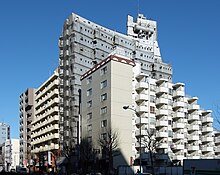Watanabe Yōji
Watanabe Yōji ( Japanese 渡邊 洋 治 ; * April 8, 1923 in Joetsu ; † 1983 ) was a Japanese architect whose buildings can be assigned to metabolism .
Life
Watanabe was born in Joetsu in 1923 and studied at Takada College of Technology until 1941. This was followed by a working period at the Nihon steel group until he was hired by the architects Kume und Partner in 1947. Until 1959 he studied a second time at Waseda University in the Yoshisaka studio in Tokyo, after which he founded his own architecture office. After the collapse of the CIAM , he took up the ideas of metabolism and attached great importance to high density, prefabrication of individual elements and the possibility of being able to expand his designs at will. This is how designs such as 'Habitat 70' arose, an answer to the 'Habitat 67' by Mosche Safdie , located in the suburban area , which he condenses and places in an urban context. His best-known building is probably the 'New Sky Building No.3' (1970, Tokyo), which is largely made of steel and is the only surviving building in its Sky Buildings. The battleship-like residential and office building in the Shinjuku district also has a high proportion of prefabricated elements and is reminiscent of the capsule architecture of Kisho Kurokawa , but does not achieve its flexibility.
buildings
literature
- Reyner Banham, Hiroyuki Suzuki: Modern Building in Japan . DVA, Stuttgart 1987, ISBN 3-421-02882-6 .
further reading:
- The architecture of Youji Watanabe, 1985, ISBN 4-7869-0055-9
| personal data | |
|---|---|
| SURNAME | Watanabe, Yōji |
| ALTERNATIVE NAMES | 渡邊 洋 治 (Japanese) |
| BRIEF DESCRIPTION | Japanese architect |
| DATE OF BIRTH | April 8, 1923 |
| PLACE OF BIRTH | Joetsu , Japan |
| DATE OF DEATH | 1983 |
